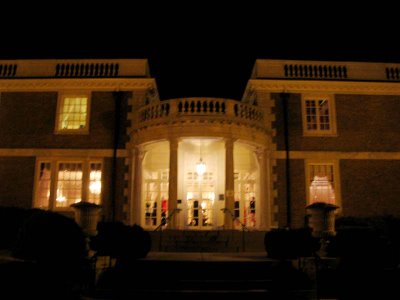Atlantic String Quartet, Strathmore Mansion
We welcome this review from Ionarts guest contributor Michael Lodico. Chamber music lovers braved a winter storm to attend the Atlantic String Quartet’s performance in the Mansion at Strathmore on Tuesday evening. The quartet was founded in 1995 and is comprised of Baltimore Symphony Orchestra members. Previous reviewers, according to the quartet’s biography, have described their playing as “explosive” and having “sent sparks flying in all directions.” Unfortunately, this vigorous, high-energy approach largely detracted from the success of Tuesday’s performance.
Chamber music lovers braved a winter storm to attend the Atlantic String Quartet’s performance in the Mansion at Strathmore on Tuesday evening. The quartet was founded in 1995 and is comprised of Baltimore Symphony Orchestra members. Previous reviewers, according to the quartet’s biography, have described their playing as “explosive” and having “sent sparks flying in all directions.” Unfortunately, this vigorous, high-energy approach largely detracted from the success of Tuesday’s performance.
The group performed Beethoven’s String Quartet in E Minor with passion and visual intensity, though this did not translate into an intense and passionate musical experience for the audience. Most of their energy was focused downward, giving a heavy, laborious sound to their playing. Many of the musicians’ attacks – when the bow meets the string to begin a phrase – were very strong and without control, which was most noticeable in the Molto Adagio movement. These rough attacks resulted in a loud accent on a note that subsequently diminished in sound, thus leading the ear and phrase nowhere. The persistent accentuation of the final notes of phrases also contributed to the heaviness of the interpretation. Lightening these final notes could have added a degree of charm to their playing.
Webern’s Langsamer Satz (Slow Movement) was written in 1905 when Webern was still under the tutelage of Arnold Schoenberg. Written in the High Romantic style, the piece has many complex chromatic attributes similar to the works of Max Reger (who was 10 years Webern’s elder). Regrettably, the Quartet seemed to approach this work as if it were avant-garde instead of entirely the opposite. Thus, basic sensitivities of Romantic-style playing, such as having an absolute legato, discreet flexibility in tempo, and carefully controlled swells in dynamics, were overlooked. Particularly, in the opening measures, the triplets in a chromatic motif were rushed. Soon afterward, the cellist entered at a faster tempo than the rest of the quartet, which prevented the seamless tranquility demanded by Webern’s composition from being achieved, until the final section. It was there that the quartet put their mutes into position, played gently, and reached a desirable level of clarity.
Brahms’s String Quartet in B-flat largely suffered the same fate as the Beethoven. The opening Vivace movement was taken at too brisk a tempo, which obscured the notes of fast runs and detracted from the strength of the movement. One could hear thousands of individual notes played horizontally in rows instead of being formed into small groupings to form three-dimensional musical shapes and a strong sense of style. The quartet played with a consistently heavy vibrato that was not used as a means to a musical end. Also, they appeared to carry a lot of tension in their bodies when playing. Instead of a single ensemble, one could hear four separate players.
However, during the third movement, interestingly marked Agitato, the stars aligned and the quartet suddenly had a tempo that was just right, subtle flexibility, and coherence. All at once one could notice the members of the quartet exchanging encouraging glances that gave the impression that they were having a powerful musical experience. Violist Christian Colberg, performing with the top two buttons of his shirt open (no tie), played with an inspiringly rich tone in the lower registers in a work that Brahms often allows the viola to lead.
This performance reminded me somewhat of the Shape-Note Sing – unaccompanied four-part colonial-era hymn singing – held in the same room just two days prior as a part of the fantastic Strathmore Education Program. At a Shape-Note Sing there is only one requirement: to sing at the top of your lungs with complete, if reckless, abandon.





















































No comments:
Post a Comment